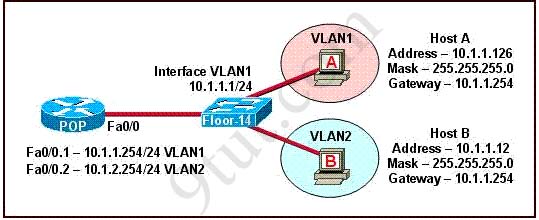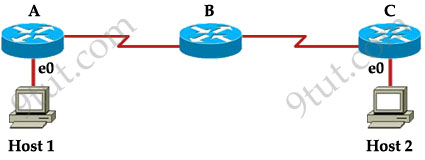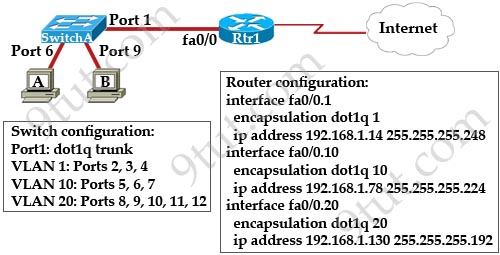New CCNA – Operation Questions
Question 1
Which command would you use on a Cisco router to verify the Layer 3 path to a host?
A. traced address
B. traceroute address
C. telnet address
D. ssh address
Answer: B
Explanation
To check the connectivity between a host and a destination (through some networks) we can use both “tracert” and “ping” commands. But the difference between these 2 commands is the “tracert” command can display a list of near-side router interfaces in the path between the source and the destination. The “traceroute” command has the same function of the “tracert” command but it is used on Cisco routers only, not on a PC -> B is correct.
Question 2
Refer to the exhibit:

Which three statements correctly describe Network Device A? (Choose three)
A. With a network wide mask of 255.255.255.128, each interface does not require an IP address.
B. With a network wide mask of 255.255.255.128, each interface does require an IP address on a unique IP subnet.
C. With a network wide mask of 255.255.255.0, must be a Layer 2 device for the PCs to communicate with each other.
D. With a network wide mask of 255.255.255.0, must be a Layer 3 device for the PCs to communicate with each other.
E. With a network wide mask of 255.255.254.0, each interface does not require an IP address.
Answer: B D E
Explanation
The principle here is if the subnet mask makes two IP addresses 10.1.0.36 and 10.1.1.70 in the same subnet then the Network device A does not need to have IP addresses on its interfaces (and we don’t need a Layer 3 device here).
A quick way to find out the correct answers is notice that all 255.255.255.x subnet masks will separate these two IP addresses into two separate subnets so we need a Layer 3 device here and each interface must require an IP address on a unique IP subnet -> A, C are not correct while B, D are correct.
With 255.255.254.0 subnet mask, the increment here is 2 in the third octet -> the first subnet is from 10.1.0.0 to 10.1.1.255, in which two above IP addresses belong to -> each interface of Network device A does not require an IP address -> E is correct.
Question 3
What are three reasons that an organization with multiple branch offices and roaming users might implement a Cisco VPN solution instead of point-to-point WAN links? (Choose three)
A. reduced cost
B. better throughput
C. broadband incompatibility
D. increased security
E. scalability
F. reduced latency
Answer: A D E
Question 4
What two things will a router do when running a distance vector routing protocol? (Choose two)
A. Send periodic updates regardless of topology changes.
B. Send entire routing table to all routers in the routing domain.
C. Use the shortest-path algorithm to the determine best path.
D. Update the routing table based on updates from their neighbors.
E. Maintain the topology of the entire network in its database.
Answer: A D
Question 5
What is the purpose of the inverse ARP?
A. to map a known DLCI to an IP address
B. to map a known IP address to a MAC address
C. to map known SPID to a MACaddress
D. to map a known DLCI to a MAC address
E. to map a known IP address to a SPID.
F. to map a known MAC address to an IP address
Answer: A
Explanation
For more information about Inverse ARP, please read my Frame Relay tutorial.
Question 6
The network shown in the diagram is experiencing connectivity problems. Which of the following will correct the problems? (Choose two.)

A. Configure the gateway on Host A as 10.1.1.1.
B. Configure the gateway on Host B as 10.1.2.254.
C. Configure the IP address of Host A as 10.1.2.2.
D. Configure the IP address of Host B as 10.1.2.2.
E. Configure the masks on both hosts to be 255.255.255.224.
F. Configure the masks on both hosts to be 255.255.255.240.
Answer: B D
Question 7
Refer to the exhibit. For what two reasons has the router loaded its IOS image from the location that is shown? (Choose two)
|
Router1> show version ROM: System Bootstrap, Version 11.1(11855) [beta 2], INTERIM SOFTWARE Router1 uptime is 23 hours, 33 minutes cisco 7206 (NPE150) processor with 57344K/8192K bytes of memory.
Configuration register is 0×2102 |
A. Router1 has specific boot system command that instruct it to load IOS from TFTP server.
B. Router1 is acting as a TFTP server for other routers.
C. Router1 cannot locate a valid IOS image in flash memory.
D. Router1 defaulted to ROMMON mode and loaded the IOS image from a TFTP server.
E. Cisco routers will first attempt to load a image from TFTP for management purposes.
Answer: A C
Explanation
When powered on, the router first checks its hardware via Power-On Self Test (POST). Then it checks the configuration register to identify where to load the IOS image from. In the output above we learn that the Configuration register value is 0×2102 so the router will try to boot the system image from Flash memory first.
But we also see a line “System image file is “tftp://112.16.1.129/hampton/nitro/c7200-j-mz”. Please notice that this line tells us the image file that the device last started. In this case it is from a TFTP server. Therefore we can deduce that the router could not load the IOS image from the flash and the IOS image has been loaded from TFTP server.
Note:
If the startup-config file is missing or does not specify a location, it will check the following locations for the IOS image:
+ Flash (the default location)
+ TFTP server
+ ROM (used if no other source is found)
Question 8
Host 1 is trying to communicate with Host 2. The e0 interface on Router C is down. Which of the following are true? (Choose two)

A. Router C will use ICMP to inform Host 1 that Host 2 cannot be reached.
B. Router C will use ICMP to inform Router B that Host 2 cannot be reached.
C. Router C will use ICMP to inform Host 1, Router A, and Router B that Host 2 cannot be reached.
D. Router C will send a Destination Unreachable message type.
E. Router C will send a Router Selection message type.
F. Router C will send a Source Quench message type.
Answer: A D
Explanation
The last known good router will try to inform you that the destination cannot be reached (with a Destination Unreachable message type) so from that information you can learn how far your packets can travel to and where the problem is.
Question 9
How is an EUI-64 format interface ID created from a 48-bit MAC address?
A. by appending 0xFF to the MAC address.
B. by prefixing the MAC address with 0xFFEE.
C. by prefixing the MAC address with 0xFF and appending 0xFF to it.
D. by inserting 0xFFFE between the upper three bytes and the lower three bytes of the MAC address
E. by prefixing the MAC address with 0xF and inserting 0xF after each of its first three bytes.
Answer: D
Explanation
We convert a 48-bit MAC address (IEEE 802) to a 64-bit value by breaking the MAC address into its two 24-bit halves. The first part is the Organizationally Unique Identifier (OUI) and the next part is the NIC specific part. Then the 16-bit hex value 0xFFFE is inserted between them to create a 64-bit value.

Just for your information, to obtain an IPv6 interface identifier from EUI-64 address, we have to complement the U/L bit (the seventh bit of the first byte and is used to determine whether the address is universally or locally administered). This means if it is a 1, it is set to 0; and if it is a 0, it is set to 1. In the above example, the U/L bit is 0 (from 00 = 0000 0000). Therefore we have to set this bit to 1 to create an IPv6 interface address.
Question 10
Refer to the exhibit:

A network administrator is adding two new hosts to SwitchA. Which three values could be used for the configuration of these hosts? (Choose three)
A. host A IP address: 192.168.1.79
B. host A IP address: 192.168.1.64
C. host A default gateway: 192.168.1.78
D. host B IP address: 192.168.1.128
E. host B default gateway: 192.168.1.129
F. host B IP address: 192.168.1.190
Answer: A C F



Q4, Q9 On 15th Feb.
Q2 was for 14th Feb Exam.
Anyone from Mumbai,India ? Has anyone used CCNA20%India scheme on the exam vouchers ?
What’s the examination fee in Mumbai ? I’ll be appearing in 2nd week of March,2015.
Thank you!
9tut or anybody that how question 10, could u pls explain it to me. thanks in advance
q10 – you have to look at router configuration to deduce what ip address can be used on which vlan and assigned to which host. Since host A is in vlan 10 he can have .79 ip and his default gateway has to be .78. Host B has to have .190 since he is in Vlan 20 and that subnet host’s are from 129-191.
Q10 Explanation:
It’s a “router-on-a-stick” configuration. Which means each host in the VLAN must corresponds with the VLAN configured on the sub-interfaces.
VLAN 10 is configured on fa0/0.10 and VLAN 20 on fa0/0.20. So each hosts in VLAN 10 must use fa0/0.10 IP address as their default gateway, each hosts must also be in the same subnet as fa0/0.10 IP – same with hosts in VLAN 20.
So find out the usable IP addresses on each sub-interfaces – for 192.168.1.78 /27: 192.168.1.65 – .94 and for 192.168.1.130 /26: 192.168.1.131 – .190
Host A (using port 6 – VLAN 10) must use IP 192.168.1.79, default gateway 192.168.1.78
Host B (using port 9 – VLAN 20) must use IP 192.168.1.190, default gateway 192.168.1.130
Correction:
For 192.168.1.130 /26 the useable addresses are: 192.168.1.128 – .190
CCNA20%India scheme works giving exam on 3rd march from mumbai
Total cost – $295
Discount – 20% = $295-$59 = $236
Payment made by credit card/debit card = Rs. 15200 (including taxes)
Question 3:
What is a “Cisco VPN solution”
What kind of “increased security” can be achieved over a VPN that is not achievable on a point-to-point WAN link such as a leased line?
Does this question appear in tests anymore? or is it a left-over from earlier exams?
Please 9tut, could you check this issue:
A. New CCNA – Operation Questions
Question 10
Refer to the exhibit:
A network administrator is adding two new hosts to SwitchA. Which three values could be used for the configuration of these hosts? (Choose three)
A. host A IP address: 192.168.1.79 **
B. host A IP address: 192.168.1.64
C. host A default gateway: 192.168.1.78
D. host B IP address: 192.168.1.128
E. host B default gateway: 192.168.1.129
F. host B IP address: 192.168.1.190
Answer: A C F
——————————————————————–
B. Composite Quiz 11
Question 23, same question:A network administrator is adding two new hosts to SwitchA. Which three values could be used for the configuration of these hosts? (Choose three)
Answers:
host A default gateway: 192.168.1.78
host B IP address: 192.168.1.190
host A IP address: 192.168.1.64 ( Answer different)**
Thanks to clarify
@bkool
host A IP address: 192.168.1.64 cannot be correct because Host A is in VLAN 10, and for that (according to exhibit) starting IP is 192.168.1.78
Thanks Mubeen
Host A IP address 192.168.1.64 is not correct because it’s the network address for VLAN 10.
Can anyone tell me, does final exam contain only questions and sims that I can find here, or it has an adittional lab simulation, that we have to set up by our own, just like we did after each term on academy.
Thanks
Question 2, the link test is asking for 3 answers but when we fill 3 answers, the feedback is a fault answer even if we are right…..Link test doesn’t work for this question “Which three statements correctly describe Network Device A? (Choose three)”
For Q 10, C and F are correct answers I think.
The address range is: 192.168.1.128 to 192.168.1.191
That means anything from and including 192.168.1.129 to 192.168.1.190 can be assigned to any interface, this including a pc or a default gateway.
I meant E and F can be the correct answers.
Passed my CCNA exam today (18th Mar)… Q2 in exam
Q5
Red, for Q10, E is incorrect because the default gateway for Host B -> port 9 -> vlan 20 is 192.168.1.130 (as shown in the diagram).
Which one is better, Academic exam or Professional exam?
Explenation for question 9 has some missing info:
When inverting the 7th bit which is 00 = 0000 0000 before we inverted is, and gets 0000 0010 = decimal number 2
So the new EUI-64 MAC is 02-12-34-FF-FE-56-78-9A instead of 00-12-34-FF-FE-56-78-9A (which was the MAC before inverting the 7th bit)
why Q4 B,C,E wrong ..can someone explain plz..??
i saw that one too, Davy….
answers on Q8 test link wonky? only marked 2 correct
, supposed to be 3 correct answers?…. no problem, just wondering why?….
Question 8 still wonky on exam. Why would Router C send a Router Selection message type?
Can someone explain Q 6 for me?
I don’t understand it.
@NK as you can note from the diagram host B is in vlan 2 and host A in Vlan 1 so the ip address and the default gateaway of host b must change to 10.1.2.254 and the ip address to 10.1.2.2. to enable frames to move
IN Q7, the first 2 bytes should be 02 instead of 00 (inversion of the 7th bit from the original MAC address to become an IPv6 address), no ?
That’swhat your write but your scheme is then wrong.
can someone please explain e why in question 10, we did not choose answer E, which gives you a fault gateway for host B at 192.18.1.129. If you look at the router configuration, it belongs in the same subnet as the IP address configured for the interface f0/0.20 . In other words, why did they choose a default gateway for host A, over host B?
@joseph
Hi! I will try my best to answer based from my understanding.
For Q10, The default gateway for the host should be the IP address of the router. Hence, default gateway for host A is 192.168.178 while the default gateway for host B is 192.168.1.130.